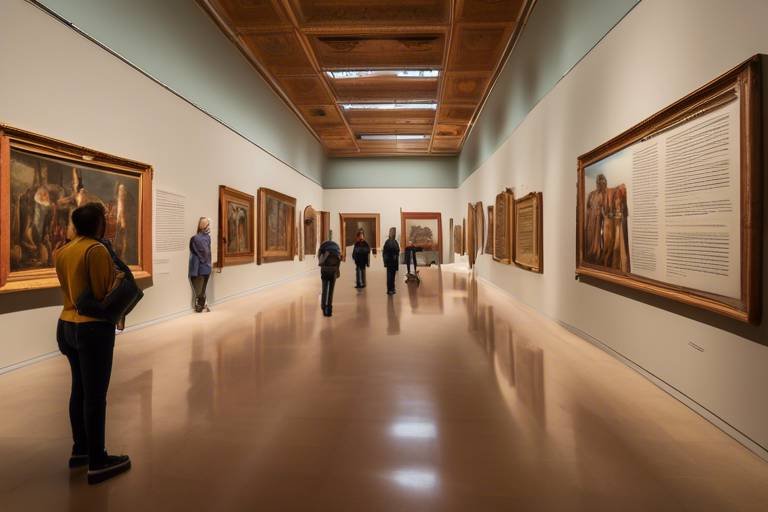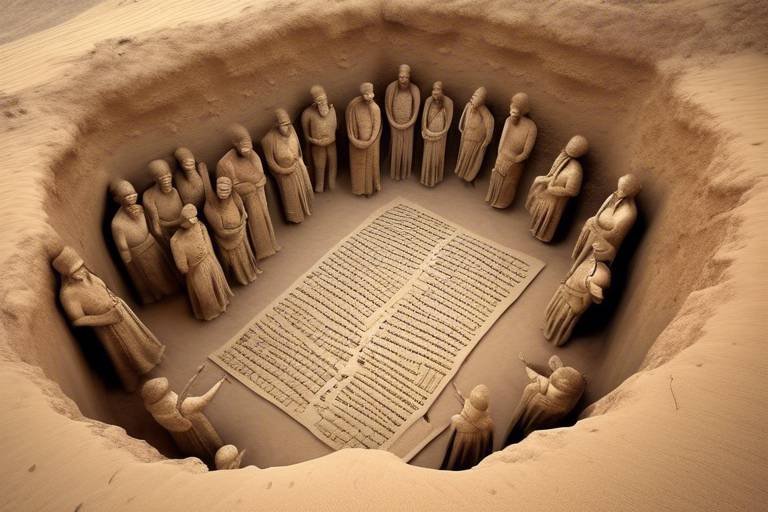The Role of Women in Modern Archaeology
Women have played a crucial role in shaping the field of archaeology, yet their contributions have often been overshadowed by male counterparts. From unearthing ancient artifacts to redefining our understanding of past civilizations, women archaeologists have left an indelible mark on the discipline.

Historical Contributions of Women Archaeologists
Women have made significant contributions to the field of archaeology, yet their roles and achievements are often overlooked. This article explores the impact of women in modern archaeology and highlights their accomplishments in a male-dominated profession.
Women have been involved in archaeology since the 19th century, with pioneers like Gertrude Bell and Dorothy Garrod making groundbreaking discoveries. Despite facing discrimination, these women paved the way for future generations of female archaeologists.
Gertrude Bell, a British archaeologist, and diplomat, played a pivotal role in the excavation and preservation of ancient sites in the Middle East. Her expertise in archaeology and passion for exploration led to significant discoveries that shaped our understanding of ancient civilizations.
Dorothy Garrod, the first female professor at the University of Cambridge, made significant contributions to Paleolithic archaeology. Her work in the field of prehistoric archaeology revolutionized our knowledge of early human cultures and migration patterns.
These pioneering women defied societal norms and overcame gender barriers to pursue their passion for archaeology. Their resilience and determination laid the foundation for future generations of women to thrive in the field.
Despite the challenges they faced, the historical contributions of women archaeologists have been instrumental in shaping the field and expanding our knowledge of the past.
Gender bias, lack of representation in leadership roles, and difficulties balancing work and family life are some of the challenges women in archaeology continue to face. Addressing these issues is crucial for achieving gender equality in the field.
In recent years, more women have been entering and excelling in the field of archaeology. Their research, fieldwork, and publications have expanded our understanding of the past and enriched archaeological scholarship.
Despite progress, women remain underrepresented in leadership positions within the archaeological community. Efforts to promote gender diversity and empower women to take on leadership roles are essential for a more inclusive and equitable field.
Intersectional perspectives, which consider how gender intersects with other aspects of identity, are crucial for promoting diversity in archaeology. Recognizing and valuing diverse voices and experiences enriches archaeological research and interpretation.
Mentorship programs, networking opportunities, and support systems play a vital role in advancing the careers of women in archaeology. Creating a supportive environment that fosters growth and professional development is essential for gender equity in the field.
As awareness of gender issues in archaeology grows, there is increasing momentum to create a more inclusive and equitable field. By advocating for gender equality, supporting women's advancement, and challenging systemic barriers, the future of women in archaeology looks promising.
It is essential to recognize and celebrate the achievements of women in archaeology, past and present. By highlighting their contributions, we honor their legacy, inspire future generations, and work towards a more diverse and equitable archaeological community.
Q: Are there any famous female archaeologists in modern times?
A: Yes, there are many notable female archaeologists in modern times, such as Kathleen Kenyon, Jane Goodall, and Sue Black, who have made significant contributions to the field.
Q: How can I support gender equality in archaeology?
A: You can support gender equality in archaeology by advocating for equal opportunities, promoting diversity and inclusion, and recognizing the achievements of women in the field.
Q: What are some initiatives to empower women in archaeology?
A: Mentorship programs, networking events, and leadership training are some initiatives that help empower women in archaeology and support their professional development.

Challenges Faced by Women in Archaeology
Women have made significant contributions to the field of archaeology, yet their roles and achievements are often overlooked. This article explores the impact of women in modern archaeology and highlights their accomplishments in a male-dominated profession.
Women have been involved in archaeology since the 19th century, with pioneers like Gertrude Bell and Dorothy Garrod making groundbreaking discoveries. Despite facing discrimination, these women paved the way for future generations of female archaeologists.
Gender bias, lack of representation in leadership roles, and difficulties balancing work and family life are some of the challenges women in archaeology continue to face. Addressing these issues is crucial for achieving gender equality in the field.
In recent years, more women have been entering and excelling in the field of archaeology. Their research, fieldwork, and publications have expanded our understanding of the past and enriched archaeological scholarship.
Despite progress, women remain underrepresented in leadership positions within the archaeological community. Efforts to promote gender diversity and empower women to take on leadership roles are essential for a more inclusive and equitable field.
Intersectional perspectives, which consider how gender intersects with other aspects of identity, are crucial for promoting diversity in archaeology. Recognizing and valuing diverse voices and experiences enriches archaeological research and interpretation.
Mentorship programs, networking opportunities, and support systems play a vital role in advancing the careers of women in archaeology. Creating a supportive environment that fosters growth and professional development is essential for gender equity in the field.
As awareness of gender issues in archaeology grows, there is increasing momentum to create a more inclusive and equitable field. By advocating for gender equality, supporting women's advancement, and challenging systemic barriers, the future of women in archaeology looks promising.
It is essential to recognize and celebrate the achievements of women in archaeology, past and present. By highlighting their contributions, we honor their legacy, inspire future generations, and work towards a more diverse and equitable archaeological community.
Women in archaeology face various challenges, including gender bias, lack of representation in leadership roles, and difficulties balancing work and family life. Overcoming these obstacles is crucial for creating a more inclusive and diverse archaeological community. By addressing these challenges, we can pave the way for greater gender equality and empower women to thrive in the field.

Advancements and Achievements of Women in Archaeology
Women have made significant contributions to the field of archaeology, yet their roles and achievements are often overlooked. This article explores the impact of women in modern archaeology and highlights their accomplishments in a male-dominated profession.
Over the years, women in archaeology have achieved remarkable advancements and made significant contributions to the field. Their dedication to research, fieldwork, and publications has not only expanded our understanding of the past but also enriched archaeological scholarship. Women archaeologists have brought fresh perspectives and innovative approaches to archaeological investigations, challenging traditional narratives and pushing the boundaries of knowledge.
One notable achievement is the discovery of previously unknown archaeological sites and artifacts by women researchers. Their meticulous excavation techniques and keen observational skills have unearthed valuable historical information, shedding light on ancient civilizations and cultural practices. Women in archaeology have also played a crucial role in interpreting and contextualizing archaeological findings, offering new insights into human history and societal development.
Furthermore, women have excelled in academic research, publishing groundbreaking studies that have influenced the direction of archaeological scholarship. Their contributions to archaeological theory and methodology have shaped the discipline and paved the way for future generations of archaeologists, both male and female. Women's voices in archaeology have led to a more diverse and inclusive field, fostering collaboration and interdisciplinary approaches to studying the past.
In addition to their scholarly achievements, women in archaeology have demonstrated exceptional leadership skills and organizational abilities. Many have taken on key roles in archaeological projects, leading teams of researchers and overseeing complex fieldwork operations. Their professionalism, expertise, and dedication have earned them respect and recognition within the archaeological community, inspiring others to follow in their footsteps.
Overall, the advancements and achievements of women in archaeology have been instrumental in shaping the field and driving progress in archaeological research. Their passion for uncovering the mysteries of the past, combined with their perseverance and resilience in the face of challenges, have made a lasting impact on the discipline and paved the way for a more inclusive and diverse archaeological community.
1. Are there any famous women archaeologists?
- Yes, there are several renowned women archaeologists who have made significant contributions to the field, such as Kathleen Kenyon, Jane Goodall, and Mary Leakey.
2. What are some common challenges faced by women in archaeology?
- Gender bias, lack of representation in leadership roles, and difficulties balancing work and family life are among the challenges women in archaeology often encounter.
3. How can we support and empower women in archaeology?
- Creating mentorship programs, promoting gender diversity, and advocating for equal opportunities are essential steps in supporting and empowering women in archaeology.

Women in Archaeological Leadership Positions
Women in Archaeological Leadership Positions play a crucial role in shaping the direction and future of the field. Despite progress in gender equality, women are still underrepresented in leadership roles within the archaeological community. Breaking through the glass ceiling, women leaders bring diverse perspectives, innovative ideas, and a unique approach to decision-making.
One of the key challenges faced by women in archaeological leadership positions is the persistent gender bias that exists in the field. Stereotypes and preconceived notions about women's abilities and leadership skills can hinder their advancement. Creating a supportive environment that values and promotes women's leadership capabilities is essential for overcoming these barriers.
Efforts to promote gender diversity and empower women to take on leadership roles are essential for creating a more inclusive and equitable field. Mentorship programs that pair aspiring female leaders with experienced professionals can provide valuable guidance and support. Additionally, organizations can implement policies that promote gender balance in leadership positions and address systemic inequalities.
Recognizing the achievements of women in archaeological leadership positions is crucial for inspiring future generations of female archaeologists. By highlighting the accomplishments of women leaders, we celebrate their contributions, challenge stereotypes, and pave the way for greater gender equality in the field. Empowering women to lead in archaeology not only benefits individuals but also enriches the discipline as a whole.

Intersectionality and Diversity in Archaeology
When we talk about diversity in archaeology, it's not just about gender. It's about recognizing the multifaceted identities and experiences that individuals bring to the field. Intersectionality plays a crucial role in understanding how factors like race, ethnicity, class, and sexuality intersect with gender to shape one's experiences and opportunities in archaeology.
Imagine archaeology as a tapestry woven with threads of different colors and textures. Each thread represents a unique aspect of a person's identity, contributing to the richness and complexity of the field. By embracing diversity and acknowledging the varied perspectives that individuals bring, archaeology becomes more vibrant and inclusive.
One way to promote intersectionality and diversity in archaeology is through collaboration. Encouraging interdisciplinary research and partnerships with diverse communities can lead to new insights and interpretations in the field. By working together, archaeologists can create a more holistic understanding of the past.
Moreover, education and awareness are key in promoting diversity in archaeology. By incorporating diverse voices and perspectives in curricula, conferences, and publications, we can challenge traditional narratives and broaden our understanding of the past. Embracing diversity not only enriches archaeological research but also fosters a more inclusive and equitable community.
Ultimately, intersectionality and diversity in archaeology are not just buzzwords—they are essential principles that shape the future of the field. By valuing and celebrating the diverse voices and experiences within archaeology, we can create a more dynamic and inclusive discipline that reflects the complexity of human history.

Mentorship and Support for Women in Archaeology
Mentorship and support are essential components for the advancement of women in the field of archaeology. Women in archaeology often face unique challenges and barriers that can be overcome with the guidance and encouragement of mentors. Mentorship programs provide valuable opportunities for women to learn from experienced professionals, gain insights into the industry, and navigate career pathways.
Establishing a supportive network is crucial for women in archaeology to thrive and succeed in a male-dominated field. Networking opportunities allow women to connect with peers, mentors, and leaders in the field, fostering collaboration, knowledge-sharing, and professional growth. Building strong relationships within the archaeological community can open doors to new opportunities and enhance career development.
Creating a supportive environment within academic institutions, research organizations, and archaeological teams is essential for promoting gender equity and empowering women in archaeology. Institutions can implement policies that support work-life balance, offer mentorship programs, and provide resources for professional development. By prioritizing mentorship and support, organizations can cultivate a culture of inclusivity and diversity in archaeology.

Future Prospects for Women in Archaeology
Women have made significant contributions to the field of archaeology, yet their roles and achievements are often overlooked. This article explores the impact of women in modern archaeology and highlights their accomplishments in a male-dominated profession.
The future prospects for women in archaeology are promising as the field continues to strive for gender equality and inclusivity. With increasing awareness of gender issues, there is a growing momentum to create a more equitable environment for women archaeologists.
Advocacy for gender equality plays a crucial role in shaping the future of women in archaeology. By challenging systemic barriers and promoting opportunities for women's advancement, the field can become more diverse and welcoming to all.
Supporting women's professional development and creating mentorship programs are essential for empowering women in archaeology. By providing guidance, networking opportunities, and a supportive environment, women can thrive in their careers and contribute significantly to the field.
Furthermore, efforts to address gender bias, promote intersectionality, and increase representation of women in leadership roles are key to ensuring a bright future for women in archaeology. Embracing diversity and valuing the unique perspectives that women bring enriches archaeological research and fosters a more inclusive community.
Celebrating the achievements of women in archaeology, both past and present, is vital for inspiring future generations and honoring the legacy of trailblazing female archaeologists. By recognizing and highlighting women's contributions, the field can continue to evolve towards a more equitable and diverse landscape.
Q: Are there specific challenges that women in archaeology face?
A: Yes, women in archaeology often encounter gender bias, lack of representation in leadership roles, and difficulties balancing work and family life.
Q: How can the archaeological community support women's advancement?
A: The archaeological community can support women's advancement by promoting gender diversity, creating mentorship programs, and providing networking opportunities.
Q: Why is it important to celebrate women's contributions to archaeology?
A: Celebrating women's contributions is essential for honoring their legacy, inspiring future generations, and fostering a more inclusive and equitable archaeological community.

Celebrating Women's Contributions to Archaeology
Women have played a crucial role in shaping the field of archaeology, yet their contributions have often been overlooked or undervalued. From pioneering excavations to groundbreaking research, women archaeologists have made significant strides in unraveling the mysteries of the past. Their dedication, perseverance, and passion for discovery have left an indelible mark on the archaeological landscape.
One of the key aspects of celebrating women's contributions to archaeology is acknowledging the challenges they have overcome to pursue their passion. Many women in archaeology have faced gender bias, discrimination, and barriers to advancement throughout their careers. Despite these obstacles, they have continued to push boundaries, challenge stereotypes, and break new ground in the field.
By highlighting the achievements of women in archaeology, we not only recognize their individual successes but also amplify their voices and experiences within the discipline. Their unique perspectives, innovative research, and collaborative efforts have enriched archaeological scholarship and broadened our understanding of ancient civilizations.
Moreover, celebrating women's contributions to archaeology serves as a powerful reminder of the importance of diversity and inclusivity in the field. By showcasing the diverse talents and accomplishments of women archaeologists, we inspire future generations to pursue careers in archaeology and foster a more equitable and supportive environment for all researchers.
Through exhibitions, publications, conferences, and online platforms, the archaeological community can continue to celebrate and promote the invaluable contributions of women in the field. By showcasing their work, sharing their stories, and honoring their legacy, we honor the past, present, and future achievements of women in archaeology.
Frequently Asked Questions
- What are some notable historical contributions of women archaeologists?
Women have been involved in archaeology since the 19th century, with pioneers like Gertrude Bell and Dorothy Garrod making groundbreaking discoveries. Despite facing discrimination, these women paved the way for future generations of female archaeologists.
- What challenges do women in archaeology face?
Gender bias, lack of representation in leadership roles, and difficulties balancing work and family life are some of the challenges women in archaeology continue to face. Addressing these issues is crucial for achieving gender equality in the field.
- How can gender diversity be promoted in archaeological leadership positions?
Efforts to promote gender diversity and empower women to take on leadership roles are essential for a more inclusive and equitable field. Mentorship programs, networking opportunities, and support systems play a vital role in advancing the careers of women in archaeology.
- Why is intersectionality important in promoting diversity in archaeology?
Intersectional perspectives, which consider how gender intersects with other aspects of identity, are crucial for promoting diversity in archaeology. Recognizing and valuing diverse voices and experiences enriches archaeological research and interpretation.
- What role do mentorship and support systems play in advancing women in archaeology?
Mentorship programs, networking opportunities, and support systems play a vital role in advancing the careers of women in archaeology. Creating a supportive environment that fosters growth and professional development is essential for gender equity in the field.
- What are the future prospects for women in archaeology?
As awareness of gender issues in archaeology grows, there is increasing momentum to create a more inclusive and equitable field. By advocating for gender equality, supporting women's advancement, and challenging systemic barriers, the future of women in archaeology looks promising.
- Why is it important to celebrate women's contributions to archaeology?
It is essential to recognize and celebrate the achievements of women in archaeology, past and present. By highlighting their contributions, we honor their legacy, inspire future generations, and work towards a more diverse and equitable archaeological community.



















